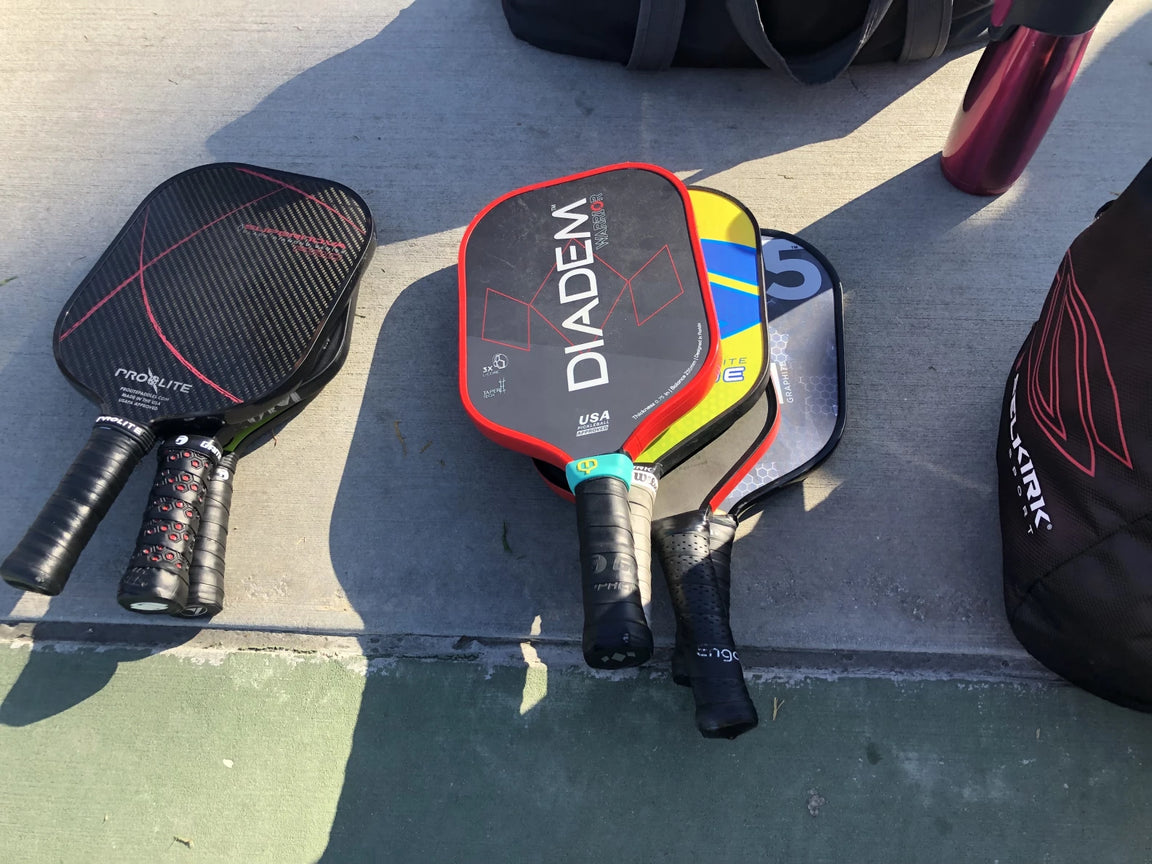Pickleball Gameplay Is it time to replace your pickleball paddle?
 Elena Arnold
Jul 14, 2022
Elena Arnold
Jul 14, 2022

Photo credit: Players at the Liberty Park pickleball court reserve a space in an upcoming game by stacking their paddles in piles of four. (Sharon McNary / LAist)
Everyone has heard the buzz by now that pickleball is America’s fastest growing sport. There are MANY reasons this is true- ask any pickleball player. One of the biggest advantages of picking up the game of pickleball is well…there’s not much equipment to pick up in order to start playing! Grab a paddle and a ball and you are ready to go. Simple, right?
It’s simple until you realize that the paddle you are playing with just isn’t working for you anymore. Are you still playing with the same paddle that you were using last summer? When I started playing, I didn’t know that paddles had a lifespan. I replaced my paddle when I saw a ‘cooler’ one that I wanted! I’m easily enticed by a fun color or design, but I also know that those features are not the correct reason to buy a paddle (they are just a nice perk). Maybe you are starting to question if your paddle needs replaced. How exactly can you tell that it is time to buy a new paddle?
As with everything in pickleball, there are many variables here. Do you play once a week or twice a day? Do you have a softer game or do you smash the ball? Do you throw your paddle when you lose a point? (Just kidding- please do not EVER do that). If we concentrate on the average player who plays 3 times a week and has a standard game of drops, drives, and dinks- that player is looking to get about 9 months- a year out of his/her paddle. You may be looking at your $200 paddle that you just purchased thinking- “that’s it?!” Go ahead and divide that $200 up by the amount of times you play and you are actually getting a great deal!
What are some signs that your paddle has gone bad? Not long ago, I hit a ball and the edge guard on my paddle cracked. That was a very clear sign that it was time to let that one go. Any damage to the handle, edge, or surface is an indication that the paddle is ready to be retired. It’s not always that blatantly obvious. Have you ever been taking a swing and heard a rattle? Or hit a ball and something just didn’t sound right? Those are signs that your paddle is “dead”. Bounce the ball around your paddle. If you hear a dull, thudding sound, that paddle most likely won’t be performing at its maximum potential.
Your paddle has a sweet spot, which is the area that you want the ball to hit. Usually this is in the center of your paddle. Different paddles have different sized sweet spots. A paddle like the Diadem Warrior EDGE provides consistency across the entire surface, effectively creating an edge to edge sweet spot. Other paddles have a smaller area, which just means you need a higher level of accuracy when contacting the ball. If you are playing and the ball is not going WHERE it used to go or HOW it used to go, then your paddle is wearing down.
Remember the days when you could fairly easily hit the ball back to the baseline on a serve or a return? If it’s been a while since that happened, then your paddle is probably starting to lose some “oomph”. If you are exerting the same amount of energy on a shot as you always have and getting a different result, it may not be you. I just switched to my Joola Vision, and I could not believe the pop that the light paddle had. I barely had to swing and my serve went sailing to the baseline. My previous paddle wasn’t even that old (but I play a lot) and I realized that my five month old paddle just wasn’t cutting it any longer.
Now think about your net game. Are you able to control most dinks without popping them up or hitting them into the net? Much of this has to do with technique, but some of it has to do with your paddle. Some paddles just offer more finesse at the net. If you’ve ever done research on paddles, you’ve probably seen that some are designed for control, whereas other are designed for power. If you start to feel that control slipping, maybe your paddle is losing some of its “touch”.
Where is your paddle right now? Is it lovingly tucked into a case or cover and gently placed into your bag? Or is it thrown in the back seat of your car ready to go whenever you pass a court? How you care for your paddle will impact its lifespan. It’s best for your paddle to avoid any extreme temperatures. Cold temperatures can weaken the paddle and even cause it to crack. Hot temperatures soften the paddle and make it less effective for control or power shots. If you do not have a cover for your paddle, you can always wrap it in a towel to add a barrier of protection. Safeguard your paddle and slip it into your pickleball bag to extend its longevity.
If you recently bought a new paddle, there are some other simple things you can do to help keep it in top notch condition. I often forget to clean my paddle. Keep a cloth (preferably microfiber) in your bag and wipe down your paddle after a day of play. If you see marks, you can even dampen the cloth and use that. Try to avoid any cleansers because those will start to wear away at the surface.
We all know that meeting at the net and tapping paddles is a sign of good sportsmanship. Make sure you are tapping those paddles and not slamming them. I’m sure you’ve met a slammer- someone who aggressively bangs paddles (maybe without even realizing it). A newer trend in pickleball is to tap handles. This will eliminate the wear and tear on your paddle face and/or edge guard. During play, it is sometimes unavoidable to hit paddles. You both go for the ball and SLAM! The once in a while hit isn’t going to hurt anything, but if this is happening several times during a game, you may need to reevaluate your style and possibly start calling the ball.
Next time you play, think about the performance of your paddle. Think about the last time you replaced your paddle. Are you getting what you want from that paddle? I’ve mentioned before that trying before buying is HUGE. Doing your research and reading about paddles is certainly step one, but then go a step further and play with that paddle. Get in contact with one of our Ambassadors, they have your back and will find a paddle that is right for you. Technology with pickleball paddles is always advancing and trying some of the newer paddles on the market may be game changing for you!